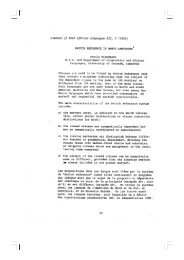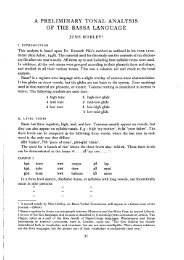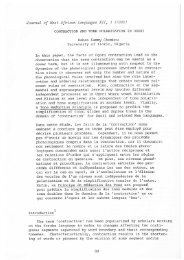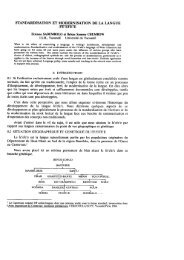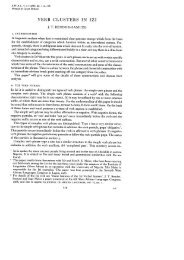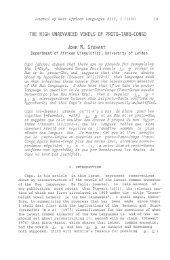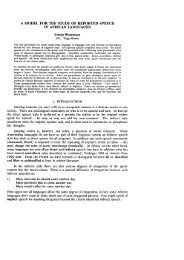The floating low tone in Bantu - Journal of West African Languages
The floating low tone in Bantu - Journal of West African Languages
The floating low tone in Bantu - Journal of West African Languages
You also want an ePaper? Increase the reach of your titles
YUMPU automatically turns print PDFs into web optimized ePapers that Google loves.
››<br />
››<br />
››<br />
››<br />
4 <strong>Journal</strong> <strong>of</strong> <strong>West</strong> <strong>African</strong> <strong>Languages</strong> XXXI.1 (2004)<br />
high fall<strong>in</strong>g (^) <strong>tone</strong> <strong>in</strong> some situations and a level high ( )<strong>in</strong> others. In the third part we<br />
attempt an analysis <strong>of</strong> the data presented, show<strong>in</strong>g with adequate illustration that the<br />
contour formation is due to a <strong>float<strong>in</strong>g</strong> <strong>low</strong> <strong>tone</strong> <strong>in</strong> the root. In the fourth part we provide<br />
evidence for the postulation <strong>of</strong> a <strong>float<strong>in</strong>g</strong> <strong>low</strong> <strong>tone</strong> <strong>in</strong> the analysis by exam<strong>in</strong><strong>in</strong>g negative<br />
noun derivations <strong>in</strong> Bafut. <strong>The</strong> paper ends with a summary conclusion.<br />
1. PRELIMINARIES<br />
1.1 A REVIEW OF BAFUT NOUN CLASSES 2<br />
<strong>The</strong> fol<strong>low</strong><strong>in</strong>g 10 noun classes have been identified for Bafut by earlier<br />
researchers (see Eastlack (1968), Dunstan (1971), Leroy (1977) Mfonyam (1989)<br />
Tamanji (1991) Neba (1998)).<br />
› (1) Cl 1a O - Cl 2 bˆ› -<br />
s bird bs birds<br />
l horse b horses<br />
kar r<strong>in</strong>g bkar r<strong>in</strong>gs<br />
kasar cassava bkasar cassavas<br />
› Cl 1b N›<br />
-<br />
ndoo husband bloo husbands 4<br />
nl greedy person bl greedy people<br />
nln old person bln old people<br />
mf chief bf chiefs<br />
› › Cl 3a ˆ› - Cl 6 m ˆ› -<br />
l palm w<strong>in</strong>e source ml palm w<strong>in</strong>e sources<br />
b s<strong>in</strong> mb s<strong>in</strong>s<br />
saa case msaa cases<br />
l ant ml ants<br />
b mushroom mb mushrooms<br />
3 This is a syllabic nasal that agrees <strong>in</strong> place <strong>of</strong> articulation with the fol<strong>low</strong><strong>in</strong>g consonant. This nasal is also<br />
attested <strong>in</strong> classes 3, 9, and 10. While it is replaced <strong>in</strong> the plural <strong>in</strong> class 1a, it is not <strong>in</strong> the other classes.<br />
4 <strong>The</strong>re are some situations <strong>in</strong> this language where [d] is realized as [l] <strong>in</strong> <strong>in</strong>tervocalic position. This<br />
change is not consistent as there are situations where [d] occurs <strong>in</strong> <strong>in</strong>tervocalic position, for example,<br />
[ad] ‘place’. This issue is out <strong>of</strong> the scope <strong>of</strong> this paper and we therefore not discuss it <strong>in</strong> any<br />
detail.



